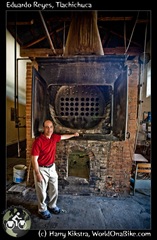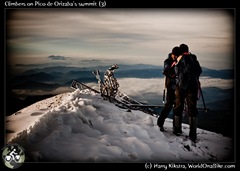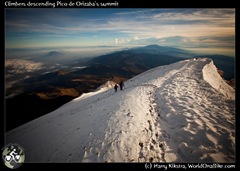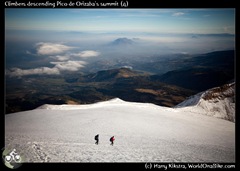Day 338-341, 14-18 June 09: Pico de Orizaba, summit of Mexico
September 20, 2009 by Harry
Filed under Trip reports, North America, Mexico, Central Mexico
14th June, From Puebla to Tlachichuca: dust devils and up the slopes of the volcano. 52km, about 500m up
After our goodbyes to Hiram’s family, we found our way through the busy streets of Puebla, heading North East to to the exit of the city, the main highway towards Veracruz on the Gulf coast. Our mums would arrive in Cancun, more than 1600km away via busy highways, in 2 weeks and we had to be there several days before to arrange accommodation, trips etc. We needed to make at least 150km per day, either cycling or taking a ride. Still there was one thing left to do, before heading for the Mexican Riviera Maya…
The toll road was busy and noisy as was to be expected and during the day we took 2 rides until we arrived at a slightly less busy road heading North (no!!!). After turning East again, we headed in the direction of a huge pile of clouds. The road looked flat, but in reality it was gently but constantly sloping up. It felt like we were cycling with our brakes stuck, or with a flat tire.
 Ivana was just 100m behind when I stopped in a small town to wait for her, but she got right in a path of a dust devil, sweeping through the streets and depositing Madre Tierra all over her. There were dust devils everywhere on the fields and we had to sprint a few times to avoid one.
Ivana was just 100m behind when I stopped in a small town to wait for her, but she got right in a path of a dust devil, sweeping through the streets and depositing Madre Tierra all over her. There were dust devils everywhere on the fields and we had to sprint a few times to avoid one.
At about 2400m altitude we reached our goal for the day: Tlachichuca, a slightly depressing town, with just one real benefit for us: it is the starting pint for ascents of the highest mountain of Mexico: Citlaltepetl, better known as Pico de Orizaba! Depending on the source, it is between 5611 & 5700m (approx 18,700ft) high.
 This makes it not only the highest point of Mexico, but also after Denali (Alaska) and Mount Logan (Canada), the 3rd highest peak in North America. It is not a technical climb, merely a long hike, but still crampons and ice-axe are needed as even though it is shrinking rapidly, there is still a glacier on the upper part.
This makes it not only the highest point of Mexico, but also after Denali (Alaska) and Mount Logan (Canada), the 3rd highest peak in North America. It is not a technical climb, merely a long hike, but still crampons and ice-axe are needed as even though it is shrinking rapidly, there is still a glacier on the upper part.
As I have many US clients for my organised 7summits.com expeditions to Kilimanjaro, Aconcagua & Elbrus, the summits of Africa, South America and Europe, it would be nice to offer a climb of Pico de Orizaba as well. It is very close to the US, affordable and a good way to test how you are doing on ice, and at a similar altitude and you can use it as pre-acclimatisation, making the other climbs a lot easier.
 I had gotten in contact with the best-known local organisation, led by the Reyes family. For many generations, this family has been an important factor for the town of Tlachichuca as well as for the exploration of the Pico.
I had gotten in contact with the best-known local organisation, led by the Reyes family. For many generations, this family has been an important factor for the town of Tlachichuca as well as for the exploration of the Pico.
 I met up with Gerardo Reyes, who showed me around their family mansion, a former soap factory, where we spent the night.
I met up with Gerardo Reyes, who showed me around their family mansion, a former soap factory, where we spent the night.
Though he could not arrange a guide at short notice, we arranged that his driver would take us to and from the base camp hut the next day, so I could climb it by myself.
15th June: Tlachichuca – Base camp Pico de Orizaba, 2400m – 4200m (8000-14,000ft)
Gerardo was kind enough to borrow me some climbing gear as I had almost nothing with me besides our camping gear. Ivana had decided that she would not climb the mountain, but she would accompany me in to the base camp for support.
The huge 4wheel drive took us through small mountain towns, through pine forests over a very bumpy sandy road. I had read that sometime people attempt to drive up here in regular cars, but it seemed completely impossible to me. It would make a nice downhill, but only on full suspension bikes; Kowalski would get a heart attack here and maybe even break something.
 The main climbing season is in winter when the hut is often completely packed with people camping outside as well. Now the hut was totally empty, leaving us to choose from the few dozen wooden spaces. We felt the altitude difference and I only went for short hike up the remains of the old defunct concrete aquaduct before heading down to the cold hut, removing several Coca Cola cans from the trail on the way down.
The main climbing season is in winter when the hut is often completely packed with people camping outside as well. Now the hut was totally empty, leaving us to choose from the few dozen wooden spaces. We felt the altitude difference and I only went for short hike up the remains of the old defunct concrete aquaduct before heading down to the cold hut, removing several Coca Cola cans from the trail on the way down.
The driver had shown us a small source of fresh and clear water and we spent the rest of the afternoon reading, cooking, eating and drinking tea and soups to hydrate well in order to prevent altitude disease.
16th June: Base camp to the glacier: 4200-5100m (14,000-17,000ft)
I woke up early for a hike up the mountain. The route description I had read and heard were very broad and vague and also outdated as the glacier had retreated considerably in recent years. For the climb to the summit I would have to find my route in the dark in order to come safely down during the day time, so today I was going to find my way up to the glacier.
The start was very easy as the concrete remains and the well-beaten path were clear. But then the path split several times forcing me to check several variations before deciding on the best one.
 The last section before the glacier had been covered by ice not so many years ago, but now it was a rocky mess. There were little ‘stone men’ and other route pointers everywhere, rendering all of them useless. This section is now called The Labyrinth, as it is easy to loose the way; that is, if you know it in the first place 🙂
The last section before the glacier had been covered by ice not so many years ago, but now it was a rocky mess. There were little ‘stone men’ and other route pointers everywhere, rendering all of them useless. This section is now called The Labyrinth, as it is easy to loose the way; that is, if you know it in the first place 🙂
Still it was not to steep and with some scrambling I found a quite straightforward way up to the plateau, where some soft sandy ridged led me to the glacier. It looked sad, more like a thin crusty snowfield than a mighty glacier. I guess that in only a matter of decades, maybe even years, it will be reduced to some scattered snow patches before disappearing forever.
It felt good to be in the mountains again. Even on a relatively easy mountain like the Pico, the fresh air, the views, the excitement, the thin air and the exercise all made me feel very alive as always. It was nice to be the only one on the mountain, the solitude makes the experience stronger.
The strong cold wind and the upcoming clouds reminded me of the force of the mountains and I hid behind some rocks to eat some sandwiches and drink more, staying as long as possible without cooling down too much, to maximise the acclimatisation effects of this reconnaissance trip. Even with searching it had taken less than 3 hours to the glacier, and from here the route would be straightforward to the summit, so I felt good about trying for the next day.
The way down through the cloudy Labyrinth turned out to be difficult to find than the way up. Several times I found myself on top of a steep drop, before the not so obvious, but much easier route down opened itself up for me.
Later that afternoon I heard a car coming and soon we were surprised by 3 new visitors: Anabel, a young climber from Spain, her boyfriend Victor and a local guide named Guadalupe.Victor was not climbing, but Anabel and her guide were going to try for the summit this night as well, so we decided to climb up together for safety and for the company.
17 June 2009: climbing in the dark
We woke up at 01.00, had our breakfast, packed everything and headed into the dark night before 2Am. It was cold outside, but at least the rainy clouds from the day before had disappeared, making way for thousands of stars. We chatted about our climbs and the mountains and time passed quickly. We went slower than I had done the day before, but as Guadalupe knew his way without any hesitation, we made it to the start of the glacier in about the same time as the day before.
 Anabel was feeling the altitude and was slowing down. After we had put on our crampons, Guadalupe tied her to his rope and went first. I followed shortly after, but did not go on the rope. I liked the feeling of climbing alone and it gave me time and space to stop for pictures without bothering anybody.
Anabel was feeling the altitude and was slowing down. After we had put on our crampons, Guadalupe tied her to his rope and went first. I followed shortly after, but did not go on the rope. I liked the feeling of climbing alone and it gave me time and space to stop for pictures without bothering anybody.
 The climb up the glacier was straightforward as expected. We slowly switch-backed our way up, while the sky in the east slowly turned purple, then orange as the sun rose behind the storm clouds of the Gulf coast, showing the mountains, clouds, cities and fields around us.
The climb up the glacier was straightforward as expected. We slowly switch-backed our way up, while the sky in the east slowly turned purple, then orange as the sun rose behind the storm clouds of the Gulf coast, showing the mountains, clouds, cities and fields around us.
 Anabel was almost grinding to a halt and was not sure if she was going to make it, but with encouragement from two sides, she continued slowly but steadily.
Anabel was almost grinding to a halt and was not sure if she was going to make it, but with encouragement from two sides, she continued slowly but steadily.
The shadow of Pico de Orizaba projecting on the fields appeared on our right when the sun made it above the clouds and with the sun came a new energy, pushing us up the glacier to the rocks of the crater rim.
The summit of Mexico!
 It was almost 07.20 when we walked along the Crater edge to the mangled iron that once was a summit cross.
It was almost 07.20 when we walked along the Crater edge to the mangled iron that once was a summit cross.
Even with the many stops on the glacier, it had taken less than 5.5 hours, which was very good.
 We congratulated each other with being the highest people between Alaska & the Andes.
We congratulated each other with being the highest people between Alaska & the Andes.
The weather was great and we took our time to eat, drink and take plenty of pictures, before heading down the glacier, here is a selection ( click to enlarge, more photos are in the photo section here).
Running down
 It was a quick walk down, as the snow already was softening and with the thicker air, Anabel’s energy returned. We sped down the rocks and were greeted outside the hut by Ivana & Victor, who were barely awake. They wondered if we had made it as it was only 10 ’o clock!
It was a quick walk down, as the snow already was softening and with the thicker air, Anabel’s energy returned. We sped down the rocks and were greeted outside the hut by Ivana & Victor, who were barely awake. They wondered if we had made it as it was only 10 ’o clock!
The others went down quickly, but we had to await our ride back, that was scheduled for the afternoon. After another bumpy ride down we arrived back at the Reyes mansion, where a warm shower was our reward.
18th June: to the lowlands!
I would not have liked to miss the great days in the mountains, but now we really had to hurry to get to Cancun in time, we had to get moving! We need to get a lot of rides or take a bus, but still there was one more section to cycle that we did not want to miss: downhill 🙂
Kowalski! Status report!
Knees are doing quite ok, and with the upcoming break in Cancun I am positive that we are able to continue cycling .
.
Here are some figures you might enjoy:
- Distance cycled: 10,241 km (6363 Miles)
- Days on the road since Prudhoe Bay, Alaska: 341
- Days actually cycling (riding days: more than 25km/15miles): 146
- Time really spent cycling (not including stops, waits, lunches etc): 695 hours for Harry, probably 750 or so for Ivana, as she cycles a bit slower.
- Average real riding time on the riding days: 4 hours and 46 minutes per day
- Average speed for Harry since Alaska: 15km/hr or 9.3mi/hr
- Flat tires: we did not really keep count, but I think about 6 for Ivana and about 5 for Harry














